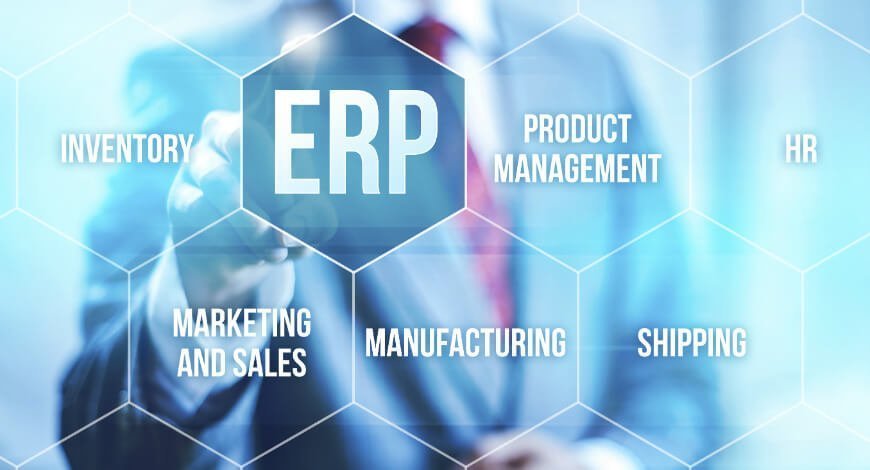Supporting your ERP system with customization? Bizzomate helps you move forward with Low-Code
24 January 2024 • Blog

Innovate alongside your existing ERP system: Low-Code offers the solution
An ERP system integrates data from various business processes, ranging from finance and inventory management to manufacturing and human resources, into a central database that, among other things, allows organizations to gain real-time insight, increase efficiency or support key decisions. Because of that central role in managing business information, the ERP system is often a crucial part of many employees’ work. Adjustments therefore have a major impact on many users and are best kept to a minimum. Still, there are situations when a modification, upgrade or replacement is needed to remain competitive. By using low-code as a flexible shell for your ERP system, you can easily add new functionality and quickly add value to your organization. How exactly? We explain that in this blog.
ERP systems: How are they used?
The task and operation of the ERP system can vary considerably from one organization to another, but common components include an organization’s financial administration, inventory management, manufacturing, purchasing, sales and human resources. Choosing ERP software is often a long-term strategic consideration. Its implementation takes a long time because it affects so many parts and employees of the organization. It is a typical example of a “system of record,” a system that every organization needs simply to function. Typically, then, an ERP system is chosen to purchase an “off-the-shelf” software package that masters all those functionalities.
ERP systems and customization
A change in the law, a new idea or a minor exception; there are times everywhere when standard software cannot adequately support business processes. They often then look to see if this can be solved with a minor tweak to the ERP system. Over time, however, this can cause ever-increasing problems, multiple small changes accumulate over time, causing the package and business information to deviate more and more from standards. Updating to a new version, for example, is therefore complex, and often has great impact. These are typical signs of an ERP system being used to do more than what it was originally intended for.
Jeroen Verhagen, Mendix consultant at Bizzomate: “A common one is an older ERP system whose support ends. Organizations are then forced to choose to upgrade to a new version, or a completely new system. At that point, they also see that the many customizations added to the ERP system over the years make that very choice so difficult.”
Such a situation can also cause reluctance for new ideas. If you know in advance that modifications to the system will take a lot of time and therefore cause resistance within the organization, it may mean that you don’t even ask the question to the IT department. In this way, an ERP system can also inhibit innovation in your organization.
Common reasons for replacement or upgrade
There are several reasons to replace or refresh the ERP system. We have listed the most important ones:
- Cost savings
- Old system is no longer supported
- Stricter security requirements
- Changing business goals
- Better performance
- Modernization
- Increased productivity
What role does Low-Code play in revamping an ERP system?
Too much customization in a system that is not designed for it thus complicates future upgrades, and yet many organizations find themselves in this situation. In those cases, low-code can help in several ways.
Jeroen: “Organizations can start on the back end by replacing their old ERP with a new system while revamping key processes and components with low-code. Take for example a very outdated interface that many users have to deal with, you can replace that part with low-code with a new, efficient and user-friendly interface. The big advantage of this is that you can build such functionalities quickly and completely as desired, thus digitizing or modernizing important business processes. Also, upgrading and maintaining a low-code application is much easier, especially if it is limited to a specific process. In this way, you ensure that the often lengthy upgrade of ERP systems does not have a major impact on your users.”
In addition to modernizing critical business processes, low-code can also be used to add new features as a flexible shell to the existing system. The same advantages apply here; the underlying ERP system continues to function in the standard way as much as possible, the new functionality is relatively quick to create, and its maintenance is a lot easier. This provides room for innovation and makes it easier for organizations to innovate by not being held back by the limitations of the ERP system. For example, we developed an app for MediReva, a medical device supplier, which interfaced with the existing ERP system and supports customer service in helping customers more quickly and in better complying with laws and regulations.
Jeroen: “ERP systems should be used primarily for standard processes. That is what they are good at and that is why they are purchased. The moment you deviate from the standard processes, it is better to look at flexible technology that is ideally suited for that customization. That has the advantage that you won’t run into problems with updates. In addition, it is much easier and faster to create customizations with low-code because it is many times more flexible than large ERP packages that are primarily designed to support a large number of organizations with standard functionality.”
Conclusion
Is your ERP system in need of replacement, but is a large amount of customization getting in your way? Or do you want to add new features that will take your business one step further? With low-code, you can quickly upgrade, add or replace functionality. That way, you can let the ERP system do what it does best and make sure that updating or replacing it is a lot more manageable than if you added a lot of extra functionality. In this way, low-code contributes to more efficient processes, rapid innovations and decreases complexity.
Supporting your ERP system with customization?
Are key business processes in dire need of renewal, or is your current system getting in the way of innovation? Bizzomate will help you further! With over a decade of experience in helping organizations move forward with low-code, together we come up with the best solution.
Get in touch with us!




